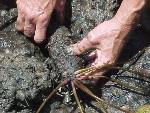
By Kit & Ben Knotts
Click images to enlarge
Because we live at the upper tip of USDA Zone 10 in Cocoa Beach, Florida, many tropical waterlilies grow all year for us. This presents a problem not present in cooler areas where tropicals go dormant, often producing tubers that provide the starts for the next season. That problem is overgrowth.
 |
|
|
|
|
Big plants with rhizomes such as those above are not uncommon for us. As long as they are not UNDER the crown of the plants, they can be left alone or cut off. Other plants must be "turned" in order for them to survive. This means getting the overgrown rhizome out from under the crown of the plant so that the eventual rotting of the rhizome doesn't kill the crown.
Tropical waterlilies grow vertically, adding pads and buds from a central crown. In good conditions, their growth can be so rampant that a pineapple-like body develops under the crown, the rhizome. Though new feeder roots develop from the active crown, old anchoring roots and old leaf bases mark the exterior of the rhizome. The interior is fleshy until it begins to rot.
In the fall, the spring and sometimes both, many tropicals grow far up out of the soil. As long as growth is active, plants appear healthy and continue to bloom. When water cools and day length shortens, overgrown plants will shrink rapidly, their leaves turning a sickly yellow-green. If left alone they will almost surely die. If repotted promptly many will recover to flower through the winter and those repotted in spring thrive in improving conditions.
The 'Panama Pacific' pictured at the top of the page has grown for years in a small shallow part of a stream in a small shallow pot, actually an oil changing pan. It is "turned" several times a year and just keeps going. The repot pictured below is from April 2002.
With most tropicals, timing of repotting in the fall is critical
to survival. Yellowing leaves is the primary indicator. There
will be few roots so that the crown can be reoriented in the
pot with little damage to existing roots. The crown will soon
return to vertical and make new roots. This will not work with
those varieties that go dormant in fall no matter what the conditions
though it may help prevent total rot of the rhizomes. It also
will not work where the water gets too very much colder than
ours in fall and winter though it will work well is spring anywhere.
Plants with overgrowth rhizomes such as these will rarely
produce tubers. Tubers are small, smooth and reddish-brown, looking
like small nuts or little  new
potatoes. Tubers will almost always produce new plants. Rhizomes
might or might not. In the picture > the rhizome at the left
will probably not produce a new plant. The one at the right has
tiny leaves at the point so may produce new plants. < Rotten
rhizomes do not pass the "squish" test, the outer shell
breaking easily to reveal inner rot.
new
potatoes. Tubers will almost always produce new plants. Rhizomes
might or might not. In the picture > the rhizome at the left
will probably not produce a new plant. The one at the right has
tiny leaves at the point so may produce new plants. < Rotten
rhizomes do not pass the "squish" test, the outer shell
breaking easily to reveal inner rot.
Viviparous Tropicals | Growing Waterlilies From Seed
"Chop and Drop" of a Large Tropical Waterlily




